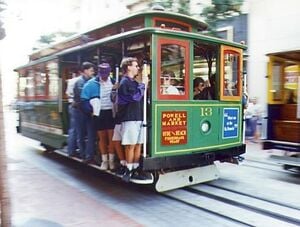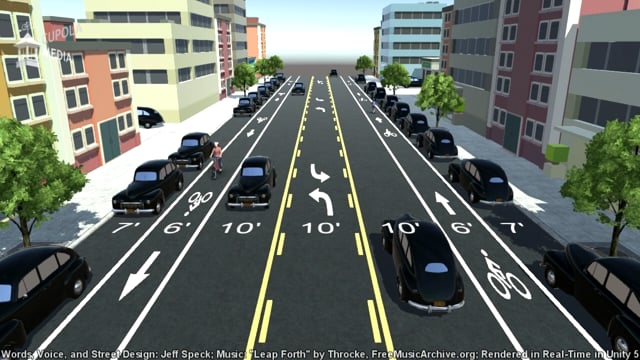
 To save its coastal rail line, California will need to move it away from the ocean, Editorial, latimes.com (Feb 09, 2024)
To save its coastal rail line, California will need to move it away from the ocean, Editorial, latimes.com (Feb 09, 2024)
Two-thirds of U.S. oil consumption is due to the transportation sector.[1]
Organisations working with communities[edit | edit source]
- Rails-to-Trails Conservancy, American nonprofit organization based in Washington, D.C. that works with communities to preserve unused rail corridors by transforming them into rail trails within the United States of America. The mission of RTC is to create a nationwide network of trails from former rail lines and connecting corridors to build healthier places for healthier people. W
Resources[edit | edit source]
Video[edit | edit source]
Citizens data initiative[edit | edit source]
Bureau of Transportation Statistics, as part of the United States Department of Transportation, compiles, analyzes, and makes accessible information on the nation's transportation systems; collects information on intermodal transportation and other areas as needed; and improves the quality and effectiveness of DOT's statistical programs through research, development of guidelines, and promotion of improvements in data acquisition and use. W
News and comment[edit | edit source]
2020

What Happened After Market Street Went Car-Free, Mar 10...[2]San Francisco
2017
101 ways to improve transportation in your city, Sep 20[3]
2015
This 2-minute video shows how bike lanes can be built without clogging up traffic, August 22[4]
2009
President Obama sets out a vision for high-speed rail in America, April 16[5]
Blogs
Rail transportation in the United States[edit | edit source]
The most culturally notable and physically evident exception to the general lack of significant passenger rail transport in the U.S. is the Northeast Corridor between Washington, Baltimore, Philadelphia, New York City and Boston, with significant branches in Connecticut and Massachusetts. The corridor handles frequent passenger service that is both Amtrak and commuter. New York City itself is noteworthy for high usage of passenger rail transport, both subway and commuter rail (Long Island Rail Road, Metro-North Railroad, New Jersey Transit). The subway system is used by one third of all U.S. mass transit users.
Other major cities with substantial rail infrastructure include Boston's MBTA, Philadelphia's SEPTA, and Chicago's elevated system and commuter rail system Metra. The commuter rail systems of San Diego and Los Angeles, Coaster and Metrolink, connect in Oceanside, California. W
High-speed rail in the United States[edit | edit source]
There is one high-speed rail service in operation, the Acela Express running in the Northeast Corridor. There are plans for higher-speed rail and high-speed rail in California, the Midwest, New England, Florida, Texas, Pennsylvania, the Pacific Northwest, Colorado / New Mexico, and the Southwestern United States. As of 2015, the California High-Speed Rail Authority is beginning construction on the California High Speed Rail project, which is planned to link Anaheim, San Francisco, San Jose, Sacramento and other major cities in the state. It will take at least until 2029 to complete, with its first stage targeted for completion in 2017. W
Mass transit in the United States[edit | edit source]
Mass transportation systems in the United States include buses, trolleybuses, trams and trains, 'rapid transit' (metro/subways/undergrounds.etc.) and ferries. Intercity public transport is dominated by airlines and intercity rail. The number of miles traveled by vehicles in the United States fell by 3.6% in 2008, while the number of trips taken on mass transit increased by 4.0%. At least part of the drop in urban driving can be explained by the 4% increase in the use of public transportation. W
Streetcars in the US[edit | edit source]
Portland, Oregon, Seattle, and Salt Lake City have built both modern light rail and modern streetcar systems, while Tucson, Oklahoma City and Atlanta have built new modern streetcar lines. A few other cities and towns have restored a small number of lines to run heritage streetcars either for public transit or for tourists; many are inspired by New Orleans' St. Charles Streetcar Line, generally viewed as the world's oldest continuously operating streetcar line. W
A couple of new modern streetcar systems are currently under construction, and a number of additional streetcar systems are in the planning stages: examples of cities with streetcar systems in the active planning stages include Los Angeles, New York City, Sacramento, and Saint Paul. W
Inland waterways of the United States[edit | edit source]
The inland waterways of the United States include more than 25,000 miles (40,000 km) of navigable waters. Much of the commercially important waterways of the United States consist of the Mississippi River System—the Mississippi River and connecting waterways. W
The ability to move more cargo per shipment makes barge transport both fuel efficient and environmentally advantageous. On average, a gallon of fuel allows one ton of cargo to be shipped 180-240 miles by truck e.g. @6-8mpg 30 ton load, 450 miles by railway, and 514 miles by barge. Carbon dioxide emissions from water transportation were 10 million metric tons less in 1997 than if rail transportation had been used. Inland waterways allow tremendous savings in fuel consumption, reduced greenhouse gas emissions and air pollution, reduced traffic congestion, fewer accidents on railways and highways, and less noise and disruption in cities and towns. W
See also[edit | edit source]
- Sustainable transport activism
- local information can be found, or shared, via our many USA location pages
External links[edit | edit source]
- Wikipedia: Rail transportation in the United States, High-speed rail in the United States, Mass transit in the United States, Inland waterways of the United States
- American Public Transportation Association, nonprofit organization which serves as an advocate for the advancement of public transportation programs and initiatives in the United States. Since its founding in 1882 (as the American Street Railway Association), APTA has educated the public about the benefits of public transportation through organized bus, paratransit, light rail, commuter rail, subways, waterborne services, high-speed rail, and intercity and passenger rail programs. It lobbies the U.S. Congress and local government bodies in favor of public transportation improvements and new developments. W
- Blue Trails, information from American Rivers


